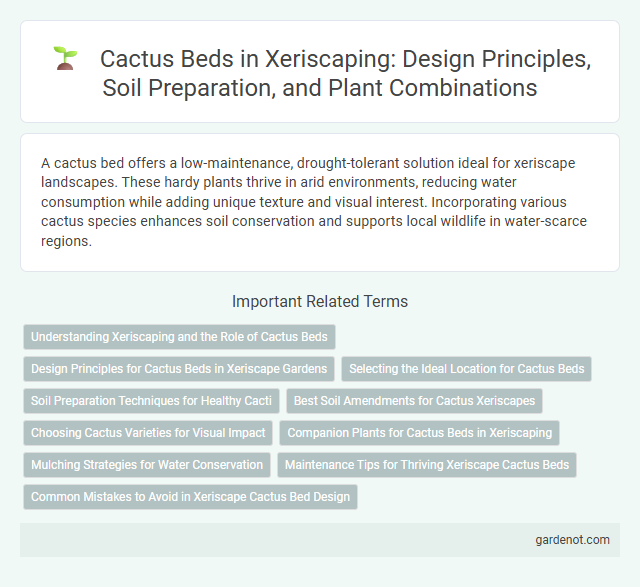A cactus bed offers a low-maintenance, drought-tolerant solution ideal for xeriscape landscapes. These hardy plants thrive in arid environments, reducing water consumption while adding unique texture and visual interest. Incorporating various cactus species enhances soil conservation and supports local wildlife in water-scarce regions.
Understanding Xeriscaping and the Role of Cactus Beds
Xeriscaping is a sustainable landscaping method that emphasizes water-efficient plant choices, making cactus beds an ideal feature due to their exceptional drought tolerance and minimal irrigation needs. Cactus beds contribute to soil conservation by reducing erosion and promoting efficient water absorption in arid environments. Integrating cactus beds in xeriscape designs enhances biodiversity while lowering landscaping maintenance and water consumption significantly.
Design Principles for Cactus Beds in Xeriscape Gardens
Cactus bed design in xeriscape gardens emphasizes water efficiency, soil drainage, and plant grouping based on sun exposure and water needs. Incorporating gravel mulch and rock features enhances moisture retention while preventing erosion. Strategic placement ensures optimal air circulation and heat tolerance, promoting healthy growth and minimal maintenance.
Selecting the Ideal Location for Cactus Beds
Selecting the ideal location for cactus beds involves choosing a site with full sun exposure, as most cacti require at least six hours of direct sunlight daily to thrive. Well-drained soil is essential to prevent root rot, so placing the bed on a slope or raised area enhances drainage. Avoid low-lying spots prone to excess moisture or frost pockets to ensure optimal growth and health for the cactus plants.
Soil Preparation Techniques for Healthy Cacti
Effective soil preparation for a cactus bed involves creating a well-draining mix comprised of coarse sand, perlite, and organic matter to prevent water retention and root rot. Testing soil pH to maintain a slightly acidic to neutral range (6.0 to 7.0) supports optimal nutrient uptake and growth for cacti species. Incorporating gravel or small rocks on the surface enhances aeration and mimics natural desert conditions, promoting healthy root development and moisture regulation.
Best Soil Amendments for Cactus Xeriscapes
Ideal soil amendments for cactus xeriscapes include coarse sand, perlite, and pumice to ensure excellent drainage and prevent root rot. Incorporating organic matter such as compost improves nutrient availability while maintaining a well-aerated substrate. Adding small amounts of gravel or decomposed granite enhances soil texture, promoting healthy cactus growth in arid landscapes.
Choosing Cactus Varieties for Visual Impact
Selecting cactus varieties with diverse shapes, sizes, and colors enhances the visual appeal of a xeriscape cactus bed. Incorporate contrasting forms like tall columnar cacti, rounded barrel cacti, and sprawling cholla to create dynamic texture and depth. Choose species with vibrant blooms and unique spine patterns to add seasonal interest and focal points in the landscape.
Companion Plants for Cactus Beds in Xeriscaping
Companion plants for cactus beds in xeriscaping include drought-tolerant species like agave, yucca, and desert marigold that complement cacti's low water needs and enhance visual appeal. Succulents such as sedum and echeveria provide variety in texture and color while thriving in similar arid conditions. Choosing native desert plants ensures compatibility with the ecosystem and reduces maintenance requirements in xeriscape gardens.
Mulching Strategies for Water Conservation
Mulching around cactus beds with organic materials like crushed gravel or decomposed granite enhances water retention and reduces evaporation by stabilizing soil temperature. Using mulch prevents soil erosion and suppresses weed growth, which competes for limited moisture in xeriscape environments. Selecting porous mulch types promotes airflow and drains excess water, ensuring optimal hydration without waterlogging delicate cactus roots.
Maintenance Tips for Thriving Xeriscape Cactus Beds
Regularly inspect cactus beds for pests such as spider mites and aphids to prevent infestations that can damage succulent tissues. Use well-draining, sandy soil to reduce root rot risks and apply mulch sparingly to retain moisture without encouraging fungal growth. Water cacti deeply but infrequently, allowing the soil to dry completely between watering sessions to mimic natural desert conditions.
Common Mistakes to Avoid in Xeriscape Cactus Bed Design
Overwatering is a common mistake in xeriscape cactus bed design, as cacti require well-draining soil and minimal moisture to thrive. Using inappropriate soil mixes that retain too much water can lead to root rot and plant decay. Placing cacti too close together or in low-light areas reduces airflow and sunlight exposure, hindering healthy growth and increasing vulnerability to pests.
Cactus bed Infographic

 gardenot.com
gardenot.com